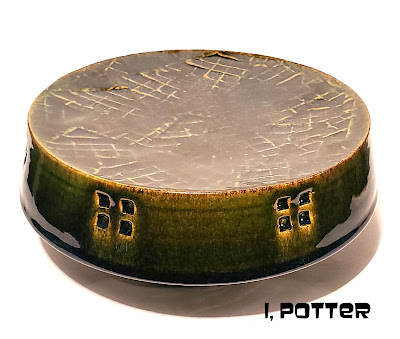Friday, July 29, 2022
CURDLED SHINO
Wednesday, July 27, 2022
SANS LEMONS
A
short while ago I was asked to make a set of these closed form serving pieces
and now that they have been fired, here is the only extra sans lemons. Being
the eternal optimist that I am I went ahead and made a total of 10, eight for
the order and two extras, one of which was the prototype. Things began to take
an ominous turn as they emerged out of the bisque as one piece cracked half way
around the footring and up the side but I forged ahead and glazed the remaining
nine pieces in the Kuro-oribe style and this is how they turned out. This
particular piece, looking a bit like some hovering space craft was the lone
extra as they all emerged in top top form which is good as I was not relishing
having to make one or two or even eight more to be honest. The top and texture
benefitted most from the iron and despite this photo highlights all the paddled
surface with some nice mottled glaze effect across the piece. With this set out
of the way I am now wondering how this would work out on a much larger scale,
perhaps time will tell.
Monday, July 25, 2022
EARLY DAYS
Friday, July 22, 2022
IRON PETALS
Kimura Ichiro (1915-1978) studied first at the Kyoto ceramic Research Center and later with Hamada Shoji starting in 1935 until set up his own studio in 1947 where though the ongoing influence of his master can be seen, he developed a unique style for himself especially seen in the myriad of "quirky" and idiosyncratic molded henko that he produced, some simply decorated and other more so in a tour de force display of his excellent command of form and space.
This particular chawan was made in a rather mature style showing restraint in the throwing, tooling, glazing and decoration and made presumably in the post-1965 period. I should note that though not exactly seen in this photo, the testure and coloration around the bottom of the bowl and kodai is rather pleasant looking like it has been banded specifically to call attention the the rustic appearance, vivid texture and feel of the foot. This Kimura Ichiro chawan is a classic piece to represent his body of work which clearly espouses the best elements of the Mingei movement with all of the functional necessity of tea ceremony or simply a bowl for udon or ramen.
Wednesday, July 20, 2022
ANOTHER VITAMIN JAR
Monday, July 18, 2022
POSITIVELY MEDIEVAL
As you can see in the photo there is a casual and spontaneous nature to how this suribachi style katakuchi was thrown, altered and then decorated, simplicity of design and creation exactly the way early Shigaraki and other medieval potters would work. The potter then let the kiln do the rest of the work and placed this piece to maximum advantage in his anagama allowing more than its fair share of ash to build up and melt creating this wet, glassy surface that is both perfect for the function of the pot and quite appealing to the eye.
Friday, July 15, 2022
HOME PHOTOS
This leads me to the color of the chawan which appears differently in all three photos that I have seen of this piece which is clearly defined as "crimson Shino". Despite the title of the piece, the true color is a crimson toned (?) rich coral color and was first decorated in iron, dipped in a thin coat of the glaze and then redipped in a more hap-hazard manner to affect the variations of the surface inside and out. As I am constantly reminded, it may not be a chawan for everyone but it is a rather poetic piece that further enriched the overall oeuvre of Tsukigata Nahiko and his pursuit for every possibility a new tradition has to offer.
Wednesday, July 13, 2022
FINE LINE
Monday, July 11, 2022
BUILT TO POUR
Friday, July 8, 2022
ECHIZEN TAKENOKO
Wednesday, July 6, 2022
MORE IS BETTER
"There is an element of luck, this is an element of trial and error, sometimes you fail, sometimes you succeed. It's not as beautifully simple as it may seem when we are talking about it." Lakhdar Brahimi
Monday, July 4, 2022
HAPPY FOURTH
Irrespective
of your politics, these two quotes go a long way to explain what is at the core
of the United States and its grand experiment;
"True
patriotism hates injustice in its own land more than anywhere else." Clarence Darrow
"May we think of freedom not as we please, but the opportunity to do what is right." Peter Marshall
Friday, July 1, 2022
BALANCE
This Oribe covered box form was made by Kato Kuniya (b.1940) who over his career in clay he has specialized in Oribe, Seto-Guro and Karatsu and exhibited at various venues including Asahi Ceramic Art Exhibition, Japan Traditional craft Exhibition and the Chunichi International Exhibition. The are elements of tradition blended with modernism and hints of Rimpa thrown in for some measures harkening back to the sylized decoration of Ogata Kenzan without being too overt about it. The interior is simple and calm by contrast though decorated with a few errant plovers exactly like those that are seen on quite a few older Oribe works as well as on various Rimpa paintings where they can be spotted about the waves and sea spay in 2 and 3 dimensions. As with much of Oribe pottery, it is the carefree attitude of this piece, both the exterior and interior that truly ties it to the early Edo tradition of the casual and playful nature nurtured over the centuries and certainly still alive and well in the pottery of many modern Oribe potters, Kato Kuniya included.



ip2.jpg)








ip.jpg)